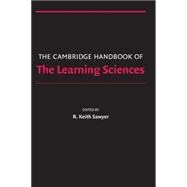
The Cambridge Handbook of the Learning Sciences
by Edited by R. Keith Sawyer-

This Item Qualifies for Free Shipping!*
*Excludes marketplace orders.
Buy New
Rent Textbook
Rent Digital
Used Textbook
We're Sorry
Sold Out
How Marketplace Works:
- This item is offered by an independent seller and not shipped from our warehouse
- Item details like edition and cover design may differ from our description; see seller's comments before ordering.
- Sellers much confirm and ship within two business days; otherwise, the order will be cancelled and refunded.
- Marketplace purchases cannot be returned to eCampus.com. Contact the seller directly for inquiries; if no response within two days, contact customer service.
- Additional shipping costs apply to Marketplace purchases. Review shipping costs at checkout.
Summary
Table of Contents
| Preface R. Keith Sawyer | |
| 1. Introduction: the new science of learning R. Keith Sawyer | |
| Part I. Foundations: 2. Foundations and opportunities for an interdisciplinary science of learning John Bransford, Brigid Barron, Roy Pea, Andrew Meltzoff, Pat Kuhl, Phil Bell, Reed Stevens, Daniel Schwartz, Nancy Vye, Byron Reeves, Jeremy Roschelle and Nora H. Sabelli | |
| 3. Constructionism Yasmin B. Kafai | |
| 4. Cognitive apprenticeship Allan Collins | |
| 5. Cognitive tutors: technology bringing learning sciences to the classroom Kenneth R. Koedinger and Albert Corbett | |
| 6. Learning in activity James G. Greeno | |
| 7. Knowledge building: theory, pedagogy, and technology Marlene Scardamalia and Carl Bereiter | |
| Part II. Methodologies | |
| 8. Learner-centered design: reflections on the past and directions for the future Chris Quintana, Namsoo Shin, Cathleen Norris, and Elliot Soloway | |
| 9. The evolution of design studies as methodology Jere Confrey | |
| 10. Design-based research: a methodological toolkit for the learning scientist Sasha Barab | |
| 11. Guiding inquiry-based math learning Paul Cobb and Kay McClain | |
| 12. Analyzing collaborative discourse R. Keith Sawyer | |
| 13. Assessing for deep understanding Sharon M. Carver | |
| Part III. The Nature of Knowledge | |
| 14. Case-based reasoning Janet L. Kolodner | |
| 15. The knowledge integration perspective on learning and instruction Marcia C. Linn | |
| 16. A history of conceptual change research: threads and fault lines Andrea A. diSessa | |
| 17. Spatial representations and imagery in learning Daniel L. Schwartz and Julie Heiser | |
| 18. Literacy and the learning sciences Annemarie Palincsar and Barbara G. Ladewski | |
| Part IV. Making Knowledge Visible | |
| 19. Project-based learning Joseph S. Krajcik and Phyllis Blumenfeld | |
| 20. Making authentic practices accessible to learners: design challenges and strategies Daniel C. Edelson and Brian J. Reiser | |
| 21. BioKIDS: an animated conversation on the development of curricular activity structures for inquiry science Nancy Butler Songer | |
| 22. Cultivating model-based reasoning in science education Richard Lehrer and Leona Schauble | |
| 23. Exploring mathematics through construction and collaboration Richard Noss and Celia Hoyles | |
| Part V. Learning Together: 24. Computer-supported collaborative learning Gerry Stahl, Timothy Koschmann, and Daniel D. Suthers | |
| 25. WILD for learning: interacting through new computing devices anytime, anywhere Roy D. Pea and Heidy Maldonado | |
| 26. Arguing to learn Jerry Andriessen | |
| 27. Learning in online communities Amy Bruckman | |
| Part VI. Learning Environments: 28. Motivation and cognitive engagement in learning environments Phyllis C. Blumenfeld, Toni M. Kempler and Joseph S. Krajcik | |
| 29. Learning as a cultural process: achieving equity through diversity Na'ilah Suad Nasir, Ann S. Rosebery, Beth Warren and Carol D. Lee | |
| 30. Prospects for transforming schools with technology-supported assessment Barbara Means | |
| 31. Internet use in schools: promise and problems Janet Ward Schofield | |
| 32. Teacher learning research and the learning sciences Barry J. Fishman and Elizabeth A. Davis | |
| 33. Scaling up: evolving innovations beyond deal settings to challenging contexts of practice Christopher Dede | |
| 34. Conclusion: the schools of the future R. Keith Sawyer | |
| Afterword: after how comes what Seymour Papert | |
| Epilogue: the fundamental issue in the learning sciences Roger C. Schank. |
An electronic version of this book is available through VitalSource.
This book is viewable on PC, Mac, iPhone, iPad, iPod Touch, and most smartphones.
By purchasing, you will be able to view this book online, as well as download it, for the chosen number of days.
Digital License
You are licensing a digital product for a set duration. Durations are set forth in the product description, with "Lifetime" typically meaning five (5) years of online access and permanent download to a supported device. All licenses are non-transferable.
More details can be found here.
A downloadable version of this book is available through the eCampus Reader or compatible Adobe readers.
Applications are available on iOS, Android, PC, Mac, and Windows Mobile platforms.
Please view the compatibility matrix prior to purchase.
